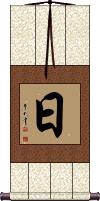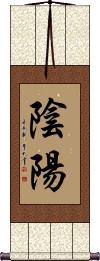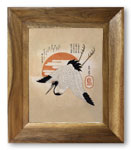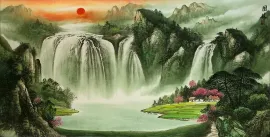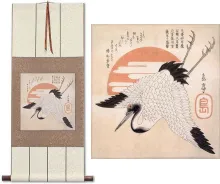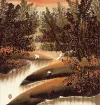Many custom options...
And formats...

Not what you want?
Try other similar-meaning words, fewer words, or just one word.
Second Sun in Chinese / Japanese...
Buy a Second Sun calligraphy wall scroll here!
Personalize your custom “Second Sun” project by clicking the button next to your favorite “Second Sun” title below...
This is how to write “day” in Chinese, Japanese, and Korean Hanja.
This can also mean “Sun,” the star in the middle of the Solar system in which we live. In Japanese, it can also mean “sunshine” or even “Sunday.”
When writing the date in modern Chinese and Japanese, putting a number in front of this character indicates the day of the month. Of course, you need to indicate the month too... The month is expressed with a number followed by the character for the moon. So “three moons ten suns” would be “March 10th” or “3/10.”
Note: This is also the first character for the proper name of Japan. Remember that Japan is “The land of the rising sun”? Well, the first character for Japan means “sun” and the second means “origin” so you get the real meaning now. Sometimes, in China, this sun character can be a short name for Japan or a suffix for something of or from Japan.
Yin Yang
陰陽 literally means yin and yang in written form (versus the common yin-yang symbol). The first character has the element of the moon, while the second character has the element of the sun so that you can see, even in written form, they suggest the balance of opposites (of night and day). You could also translate this title as “sun and moon.”
Note: This title is often misspelled as Ying Yang instead of Yin Yang.
See Also: Taoism
Nixon
This in-stock artwork might be what you are looking for, and ships right away...
Gallery Price: $67.00
Your Price: $36.88
Gallery Price: $61.00
Your Price: $33.88
Gallery Price: $61.00
Your Price: $33.88
Gallery Price: $61.00
Your Price: $33.88
Gallery Price: $61.00
Your Price: $33.88
Gallery Price: $96.00
Your Price: $52.88
Gallery Price: $72.00
Your Price: $39.88
Gallery Price: $120.00
Your Price: $79.88
Not the results for second sun that you were looking for?
Below are some entries from our dictionary that may match your second sun search...
| Characters If shown, 2nd row is Simp. Chinese |
Pronunciation Romanization |
Simple Dictionary Definition |
三光 see styles |
sān guāng san1 guang1 san kuang sankou / sanko さんこう |
the sun, the moon, and the stars (1) (poetic term) the Sun, the Moon and the stars; (2) {hanaf} three 20-point cards (high-scoring meld); (personal name) Miteru (三光天) Sun, moon, and stars. Also, in the second dhyāna of the form-world there are the two deva regions 少光天, 無量光天, and 光音天q.v. Also 觀音 Avalokiteśvara is styled 日天子sun-prince, or divine son of the sun, 大勢至 Mahāsthāmaprapta is styled 月天子 divine son of the moon, and 虛空藏菩薩 the bodhisattva of the empyrean, is styled 明星天子 divine son of the bright stars. |
三照 see styles |
sān zhào san1 zhao4 san chao sanshō |
The three shinings; the sun first shining on the hill-tops, then the valleys and plains. So, according to Tiantai teaching of the Huayan sūtra, the Buddha's doctrine had three periods of such shining: (a) first, he taught the Huayan sūtra, transforming his chief disciples into bodhisattvas; (b) second, the Hīnayāna sūtras in general to śrāvakas and pratyeka-buddhas in the Lumbinī garden; (c) third, the 方等 sūtras down to the 涅槃經 for all the living. See the 六十華嚴經 35, where the order is five, i.e. bodhisattvas, pratyekabuddhas, śrāvakas, lay disciples, and all creatures. |
反切 see styles |
fǎn qiè fan3 qie4 fan ch`ieh fan chieh hansetsu はんせつ |
traditional system expressing the phonetic value of a Chinese character using two other characters, the first for the initial consonant, the second for the rhyme and tone fanqie; traditional Chinese spelling system in which two characters are used: the first one for the onset, the second one for rhyme and tone The system of indicating the initial and final sounds of a character by two others, ascribed to Sun Yen 孫炎 in the third century A D., arising out of the translit. of Sanskrit terms in Buddhist translation. |
迦葉 迦叶 see styles |
jiā shě jia1 she3 chia she kashou / kasho かしょう |
(person) Kasyapa (Hindu sage); Kashou (迦葉波) kāśyapa, 迦攝 (迦攝波) inter alia 'a class of divine beings similar to or equal to prajāpati'; the father 'of gods, demons, men, fish, reptiles, and all animals'; also 'a constellation'. M.W. It is intp. as 'drinking light', i.e. swallowing sun and moon, but without apparent justification. (1) One of the seven or ten ancient Indian sages. (2) Name of a tribe or race. (3) Kāśyapa Buddha, the third of the five buddhas of the present kalpa, the sixth of the seven ancient buddhas. (4) Mahākāśyapa, a brahman of Magadha, who became one of the principal disciples of Śākyamuni, and after his death became leader of the disciples, 'convoked and directed the first synod, whence his title Ārya Sthavira (上坐, lit. chairman) is derived.' Eitel. He is accounted the chief of the ascetics before the enlightenment; the first compiler of the canon and the first patriarch. (5) There were five Kāśyapas, disciples of the Buddha, Mahā-Kāśyapa, Uruvilā-Kāśyapa, Gayā-Kāśyapa, Nadī-Kāśyapa, and Daśabala-Kāśyapa; the second, third, and fourth are said to have been brothers. (6) A bodhisattva, whose name heads a chapter in the Nirvana Sutra. (7) 迦葉摩騰 Kāśyapa-Mātaṅga, the monk who with Gobharana, or Dharmarakṣa, i.e. Zhu Falan 竺法蘭, according to Buddhist statements, brought images and scriptures to China with the commissioners sent by Mingdi, arriving in Luoyang A.D. 67. |
宋慶齡 宋庆龄 see styles |
sòng qìng líng song4 qing4 ling2 sung ch`ing ling sung ching ling |
Song Qingling (1893-1981), second wife of Sun Yat-sen 孫中山|孙中山[Sun1 Zhong1 shan1], influential political figure in China after Sun's death in 1925 |
阿彌陀 阿弥陀 see styles |
ā mí tuó a1 mi2 tuo2 a mi t`o a mi to Amida あみだ |
(out-dated kanji) (1) (Buddhist term) Amitabha (Buddha); Amida; (2) (kana only) (abbreviation) ghostleg lottery; ladder lottery; lottery in which participants trace a line across a lattice pattern to determine the winner; (3) (kana only) (abbreviation) wearing a hat pushed back on one's head (阿彌) amita, boundless, infinite; tr. by 無量 immeasurable. The Buddha of infinite qualities, known as 阿彌陀婆 (or 阿彌陀佛) Amitābha, tr. 無量光 boundless light; 阿彌陀廋斯Amitāyus, tr. 無量壽 boundless age, or life; and among the esoteric sects Amṛta 甘露 (甘露王) sweet-dew (king). An imaginary being unknown to ancient Buddhism, possibly of Persian or Iranian origin, who has eclipsed the historical Buddha in becoming the most popular divinity in the Mahāyāna pantheon. His name indicates an idealization rather than an historic personality, the idea of eternal light and life. The origin and date of the concept are unknown, but he has always been associated with the west, where in his Paradise, Suikhāvatī, the Western Pure Land, he receives to unbounded happiness all who call upon his name (cf. the Pure Lands 淨土 of Maitreya and Akṣobhya). This is consequent on his forty-eight vows, especially the eighteenth, in which he vows to refuse Buddhahood until he has saved all living beings to his Paradise, except those who had committed the five unpardonable sins, or were guilty of blasphemy against the Faith. While his Paradise is theoretically only a stage on the way to rebirth in the final joys of nirvana, it is popularly considered as the final resting-place of those who cry na-mo a-mi-to-fo, or blessed be, or adoration to, Amita Buddha. The 淨土 Pure-land (Jap. Jōdo) sect is especially devoted to this cult, which arises chiefly out of the Sukhāvatīvyūha, but Amita is referred to in many other texts and recognized, with differing interpretations and emphasis, by the other sects. Eitel attributes the first preaching of the dogma to 'a priest from Tokhara' in A. D.147, and says that Faxian and Xuanzang make no mention of the cult. But the Chinese pilgrim 慧日Huiri says he found it prevalent in India 702-719. The first translation of the Amitāyus Sutra, circa A.D. 223-253, had disappeared when the Kaiyuan catalogue was compiled A.D. 730. The eighteenth vow occurs in the tr. by Dharmarakṣa A.D. 308. With Amita is closely associated Avalokiteśvara, who is also considered as his incarnation, and appears crowned with, or bearing the image of Amita. In the trinity of Amita, Avalokiteśvara appears on his left and Mahāsthāmaprāpta on his right. Another group, of five, includes Kṣitigarbha and Nāgārjuna, the latter counted as the second patriarch of the Pure Land sect. One who calls on the name of Amitābha is styled 阿彌陀聖 a saint of Amitābha. Amitābha is one of the Five 'dhyāni buddhas' 五佛, q.v. He has many titles, amongst which are the following twelve relating to him as Buddha of light, also his title of eternal life: 無量光佛Buddha of boundless light; 無邊光佛 Buddha of unlimited light; 無礙光佛 Buddha of irresistible light; 無對光佛 Buddha of incomparable light; 燄王光佛 Buddha of yama or flame-king light; 淸淨光佛 Buddha of pure light; 歡喜光佛 Buddha of joyous light; 智慧光佛 Buddha of wisdom light; 不斷光佛 Buddha of unending light; 難思光佛 Buddha of inconceivable light; 無稱光佛Buddha of indescribable light; 超日月光佛 Buddha of light surpassing that of sun and moon; 無量壽 Buddha of boundless age. As buddha he has, of course, all the attributes of a buddha, including the trikāya, or 法報化身, about which in re Amita there are differences of opinion in the various schools. His esoteric germ-letter is hrīḥ, and he has specific manual-signs. Cf. 阿彌陀經, of which with commentaries there are numerous editions. |
二次革命 see styles |
èr cì gé mìng er4 ci4 ge2 ming4 erh tz`u ko ming erh tzu ko ming |
Second Revolution, campaign from 1913 of the provisional revolutionary government (under Sun Yat-sen and the Guomindang) against Yuan Shikai 袁世凱|袁世凯[Yuan2 Shi4 kai3] and the Northern Warlords |
民權主義 民权主义 see styles |
mín quán zhǔ yì min2 quan2 zhu3 yi4 min ch`üan chu i min chüan chu i |
democracy; civil liberties; principle of democracy, the second of Dr Sun Yat-sen's 孫中山|孙中山 Three Principles of the People 三民主義|三民主义 (at the time, meaning widespread popular involvement in affairs of state) |
The following table may be helpful for those studying Chinese or Japanese...
| Title | Characters | Romaji (Romanized Japanese) | Various forms of Romanized Chinese | |
| Day | 日 | hi / nichi | rì / ri4 / ri | jih |
| Yin Yang | 陰陽 阴阳 | in you / inyou / in yo | yīn yáng / yin1 yang2 / yin yang / yinyang | |
| Nixon | 尼克森 | ní kè sēn ni2 ke4 sen1 ni ke sen nikesen | ni k`o sen nikosen ni ko sen |
|
| In some entries above you will see that characters have different versions above and below a line. In these cases, the characters above the line are Traditional Chinese, while the ones below are Simplified Chinese. | ||||
Successful Chinese Character and Japanese Kanji calligraphy searches within the last few hours...
